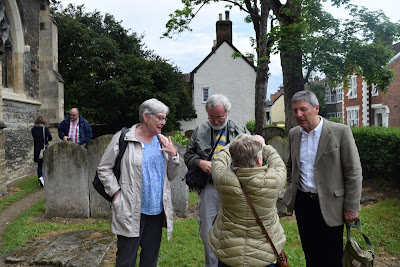by Glenn N. Holliman
Our Second Stop – St. Mary’s Parish,
Now the Albion Archaeology Centre
Bedford, Bedfordshire
May 18, 2019
Thomas
Hollyman, most likely born in the early 1580s, grew up in a wealthy home in Sherington, Buckinghamshire, some 10 or so miles from his adult home of Bedford. The second son (of a third son), he inherited 40 pounds but no land, when his father died in 1589. His parents were Christopher and Margaret Lee Hollyman of families from Cuddington and Dinton, Buckinghamshire.
Did his inheritance eventually fund an apprenticeship in Bedford? We know from Anne Holmes’ research that Thomas worked as a cordwainer or leather maker before he took a lease-hold on the Blue Boar Inn, on Cauldwell Street, several hundred yards to the west of St. Mary’s Church. Later his son-in-law, Barnabas Crash, seems to have gone into business with him.
As a cordwainer, he must have fashioned shoes, leather
garments and harnesses for horses. Undoubtedly his second son, Christopher, was
exposed to this occupation, and perhaps supported himself as a leather worker
when he arrived in Jamestown, Virginia in 1650.
Below, Elisabeth Krueger Ahrens and her mother, Anne Holliman Krueger, daughter
of Walter O. Holliman (1927-2003) who did so much to research and capture the
stories of the Holliman and allied families in the USA. Both Elisabeth and Anne are international teachers.
The files in this photograph's background are of archaeological investigations in the Bedfordshire area, research often required before new construction in the United Kingdom. This picture was taken in the interior of St. Mary's Parish which held its last service in 1975 and in 1991 became a research centre.
Did Thomas curse his fate?
The nephews and nieces of his mother,
Margaret Lee Hollyman, were on the rise socially and financially. Margaret’s brother, one Thomas Lee, married Eleanor Hampden who inherited Hartwell House, now a National Trust property which I will write about
later.
The Lees were rising and the Hollymans declining. Thomas Lee died a knight in 1626. Our Thomas Hollyman, Lee's nephew, mended shoes and served ale at a Bedford Inn.
One can imagine the envy felt by Thomas. Unlike he, one of his sisters, Ursala, inherited well from her grandmother of the same name, Ursala Yates Lee.
The Lees were rising and the Hollymans declining. Thomas Lee died a knight in 1626. Our Thomas Hollyman, Lee's nephew, mended shoes and served ale at a Bedford Inn.
One can imagine the envy felt by Thomas. Unlike he, one of his sisters, Ursala, inherited well from her grandmother of the same name, Ursala Yates Lee.
Did
his mother Margaret help support Thomas and get him started as an inn keeper in
Bedford? We do not know.
What
impact did the English Civil War, which began in 1642 and did not end until
1652, have on the family? Did our
Christopher (1618-1691) serve in the Parliamentary forces which were supported by the Hampden family?
Bedford citizenry were generally pro-Parliament and Anti-Royalist. Young John Bunyan, a Bedford resident, and later a charismatic preacher and author of ‘Pilgrims Progress’, served in the Cromwellian forces. Christopher’s younger brother, Steve, later associated with Bunyan's Meeting House services.
Bedford citizenry were generally pro-Parliament and Anti-Royalist. Young John Bunyan, a Bedford resident, and later a charismatic preacher and author of ‘Pilgrims Progress’, served in the Cromwellian forces. Christopher’s younger brother, Steve, later associated with Bunyan's Meeting House services.
Or did Christopher join the King’s army?
We know the priest at St. Mary’s, Dr. Giles Thorne, from 1630 to 1671, was arrested by Parliament and jailed for four years in 1640s. This royalist was accused of ill vices such as maypole dancing and praying for the King! St. Mary’s was the Hollyman family’s parish.
We know the priest at St. Mary’s, Dr. Giles Thorne, from 1630 to 1671, was arrested by Parliament and jailed for four years in 1640s. This royalist was accused of ill vices such as maypole dancing and praying for the King! St. Mary’s was the Hollyman family’s parish.
Also Christopher’s grandfather,
an earlier Christopher Hollyman (d 1589) served as a member of Queen
Elizabeth’s Guard, an elite royalist honor probably obtained through Lee family
connections.
The interior of St. Mary's in 1851, now lined with files and books, but the monuments and stained glass windows remain.
What
we do know is our Christopher along with his spinster sister, Judith, left
Bedford in early 1650 and arrived in Virginia in May 1650. Did they flee the chaos of civil war? Had Christopher fought on the losing side, as
King Charles I was beheaded in January 1649? Had his father, Thomas, died and
why leave an elderly mother (age 60 or so) to cross the ocean?
The Birth and Grave Sites of Christopher Hollyman, 1618-1691, have now been Visited by Descendants
In April 2016 at the Hollyman gathering in Isle of Wight, Virginia, Billy Joe Holleman,
owner of some of the original plantation of Christopher (d 1691) took our group
to what is believed to be the original burial plot of the Hollymans of
Virginia. There we assembled and asked
ourselves, is this the final resting spot of the immigrant who left England in
1650 and with his sister Judith braved the Atlantic and settled in the New
World founding our American family?
Below Susan White, center, in April 2016 with Holleman cousins at the
possible grave of Christopher Hollyman (1618-1691) in Isle of Wight, Virginia. This site, cleared for us by Billy Joe Holleman, is part of the original plantation of Christopher.
This
picture, taken in May 2019, represents an odyssey of discovery taken full
circle from the birthplace in England to grave site in Virginia of the ancestor who dared to come to
America and founded our family in the New World.
Next blog, a lunch break at the historic Swan Hotel in
Bedford.














No comments:
Post a Comment